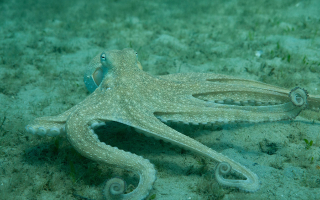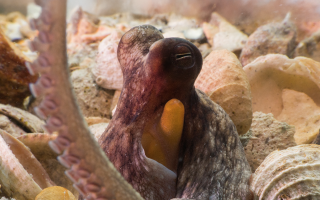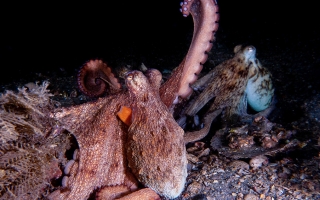California Two-Spot Octopus

California two-spot octopuses (Octopus bimaculoides) sometimes called “Bimacs” for short, gets their common name from the iridescent blue circles, known as ocelli, on both their sides. Their skin is a mottled brown color, but can change the color and texture to hunt, hide, and mate.
Bimacs have three hearts, two gills, blue blood, and a donut-shaped brain. Like other members of the cephalopod class, it can instantaneously change color, regrow arms, and uses jet propulsion to move through the water. Its eight arms exhibit incredible flexibility and dexterity. The arms are lined with hundreds of suckers an octopus can use to “taste” its surroundings.
Like most octopuses, O. bimaculoides die after the first time they reproduce. After mating, octopus mothers guard their eggs for two to four months, during which they stop eating and quickly deteriorate.
Type: Cephalopod
Habitat: Intertidal rocky reefs, frequently hides in man-made pipes
Range: Central California to northern Baja California
Life Span in the Wild: 1- 1.5 years
Size: up to 18 inches
Weight: up to 1.5 kg
Diet: Carnivorous, preys on small mollusks and crustaceans
Status: Species of Least Concern
Scientists at the MBL study Octopus bimaculoides as a model for development, neuroscience, and behavior. Bimacs are one of two species of octopus cultured at the MBL. In 2015, Octopus bimaculoides became the first cephalopod to have its genome fully sequenced. MBL scientists are studying how its genome compares to the human genome and are developing tools to test the genetics behind octopus brain, behavior, and their strange, alien-like systems for changing color and jet propulsion
Octopuses have the most flexible appendages known in nature. MBL Senior Scientist Roger Hanlon and his lab study the limb dexterity of octopuses. Using cephalopods at the MBL, UChicago’s Melinda Hale uncovered new information about the octopus nervous system: a structure by which the intramuscular nerve cords that help the animal sese its arm movement connect on the opposite sides of the animal. These kinds of new insights could uncover design principles that can inspire the creation of next-generation soft robots.



